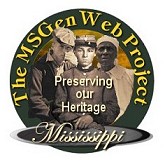
Pontotoc County, Mississippi
Genealogy and History
Peggy A. Young, County CoordinatorJeff Kemp - State Coordinator Denise Wells - Assistant State Coordinator
Ann Allen Geoghegan - Assistant State Coordinator
Friday, 13-Jun-2025 04:42:01 CDT

W. P. A. History of Pontotoc County, Mississippi
Chapter IV: FLORA
Our predecessors found in Mississippi a country clothed in the green of forests and prairie grasses, interspersed with a variety of wild flowers, herbs, and berries seldom excelled. The usefulness of this flora in providing shelter, fuel, transportation and food had much to do with early settlements; and later, in supplying our greatest manufacturing interests and industry with its raw materials. Towns, cities, railways, and ports were built, in many instances, almost entirely unsought for the upbuilding of our lusty county.
From the pines of south Mississippi to the hardwoods of the delta and the mixed growth of the hills, the same general characteristics involve the use and abuse of our natural vegetation . The story is filled with romance, woe, and good fortune, as is evidenced by this presentation of the study of flora in Pontotoc County. (1)
Economic Value of Forests
Trees improve and build up the soil. The leaves, small twigs, and other tree-litter decompose and form a layer of dark-colored vegetable mold which enriches the soil and stores up soil moisture. By means of this layer of mold, the binding of the soil by the roots of the trees, and the resistance of the trunks to the rapid flow of water, the woods prevent floods from washing or destroying the land by erosion, particularly on steep slopes.
Even if a farmer sells no timber, the woodland pays. The fire-wood, fence posts, material for repair and construction on the farm, and the time and money saved by having them conveniently on hand make woodlands valuable assets for farmers. The protections against extremes of weather afforded the crop, farm buildings, and stock are worth considerably more than the slight trouble and expense of raising and caring for the trees. A permanent woodland is an essential part of a well-equipped farm; and , more than ever before, farm woodlands have become a valuable asset, convertible into money. (2) Scalable timber, supplying wood for farm needs, furnishing employment for men and teams in winter making waste lends yield a profit, and increasing the sale value of the farm, add to the value of the forest.(3)
Pine timber is the most important product of the forests of Pontotoc County. It is primarily valuable for lumber but is also used for stove and cord-wood. In 1935 approximately two and one-half million board feet of lumber were cut in this county. (4)
Although pine timber is the principal forest product there are other trees which have some commercial value, and, of these, hickory and oak are next in importance. Hickory is shipped to handle factories, most of it being cut in the form of butts. Five hundred cords of hickory butts and six hundred cords of gum and sycamore butts were shipped from this county in 1935.
Crossties form one of the largest products of this county; an approximate estimate of the annual shipment is 50,000, and plenty of timber is available for making this product. (5)
(1) Mrs. G. M. Reeves, chairman Conservation Department, Mississippi Federation of Women's Clubs, Jackson, Miss.
(2) "Forestry and Farm Income," Farmers Bulletin #1117 (U. S. Dept of Agriculture) pp. 3 - 4 .
(3) Ibid., p. 17
(4) Brett Jackson, Pontotoc, Miss.
(5) Roy Guthrie, Pontotoc Lumber Co., Pontotoc, Miss.
Back Contents Next